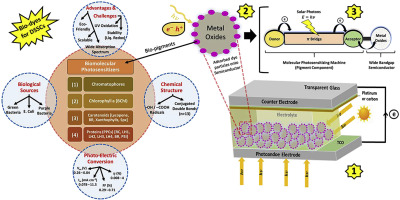Renewable and Sustainable Energy Reviews ( IF 16.3 ) Pub Date : 2020-01-20 , DOI: 10.1016/j.rser.2019.109678 Hisham A. Maddah , Vikas Berry , Sanjay K. Behura

|
Dye-sensitized solar cells based on bacterial-based photosensitizers (bio-sensitized DSSCs) are promising bio-photoelectronic molecular devices exhibiting enhanced electron excitation, injection, and dye regeneration for efficient photon-to-electron quantum-conversion. Achieving high DSSCs performance via environmentally sustainable, cost-effective, and naturally-sensitized plant-based or bacterial-based biomolecules remains a challenge. Here, we provide a comprehensive study on the mechanisms involved in the utilization of biomolecular bacterial-based pigments (e.g. proteins and carotenoids) for an improved bio-sensitized DSSCs performance. Protein complexes and chlorophyll a/carotenoids are among many bio-photosensitizers demonstrating high incident photon-to-current efficiency (IPCE). Pigments molecular structure, donor-π-acceptor conjugation, and anchoring groups have been discussed and attributed to theoretical dye HOMO–LUMO bandgaps and their corresponding bio-sensitized DSSCs IPCE. This review provides critical understanding of advancements towards natural photosensitization: (i) carboxyl/hydroxyl groups attached to acceptor segments provide firm attachment and rapid electron injection, (ii) proteins/carotenoids hybrid dyes induce visible-light photosensitivity and broaden absorbance, (iii) increased conjugated -bonds (n > 13) develop pigment visible-NIR absorption with intensified photoactivity, (iv) chromatophores integrated with bio-electrolyte provide a unidirectional flow of electrons, (v) reaction center (RC)-sensitized DSSCs have better optoelectronic properties than light-harvesting complex (LH2) due to its efficient charge separation, (vi) antioxidants hinder degradation of pigmented-photoanodes from UV radiation, (vii) solid-state redox improves device stability and dye neutralization; which all together would boost the dye sensitization performance in bio-sensitized DSSCs. The highest recorded IPCEs are found for TiO2-based DSSCs using plant-based coumarin (9%) and from [A. amentacea + P. pterocarpum] pigments (8.22%). Futuristically, we anticipate that these biologically-derived photosensitizers can be integrated into photoanodes for photoelectronic applications including DSSCs, multi-junction cells, photodiodes, phototransistors, photodetectors, flexible bioelectronic films and clothes, bio-LEDs, and photo-tunneling junctions.
中文翻译:

用于染料敏化太阳能电池的生物分子光敏剂:最新进展和关键见解
基于细菌的光敏剂(生物敏化的DSSC)的染料敏化太阳能电池是有前途的生物光电子分子器件,其显示出增强的电子激发,注入和染料再生能力,可实现有效的光子-电子量子转换。通过实现高DSSC性能具有环境可持续性,成本效益和自然敏感的基于植物或细菌的生物分子仍然是一个挑战。在这里,我们提供了有关利用生物分子细菌基颜料(例如蛋白质和类胡萝卜素)改善生物敏化DSSCs性能的机制的全面研究。蛋白质复合物和叶绿素a /类胡萝卜素是许多生物光敏剂之一,这些光敏剂显示出高入射光子电流效率(IPCE)。已经讨论了颜料的分子结构,供体-π-受体共轭和锚定基团,并将其归因于理论染料HOMO-LUMO带隙及其相应的生物敏化DSSC IPCE。这篇评论提供了对自然光敏化进展的批判性理解:-键(n> 13)产生色素可见光-近红外(NIR)吸收并具有增强的光活性,(iv)与生物电解质集成的色谱提供单向电子流,(v)反应中心(RC)敏化的DSSC具有比光更好的光电性能-捕集络合物(LH2),由于其有效的电荷分离;(vi)抗氧化剂阻碍了有色光阳极从紫外线辐射中降解;(vii)固态氧化还原改善了器件稳定性和染料中和作用;这些都将提高生物敏化DSSC中的染料敏化性能。使用基于植物的香豆素(9%)和[A. ],发现基于TiO 2的DSSC的IPCE记录最高。淡紫色+ 紫檀]颜料(8.22%)。从未来的角度来看,我们预计这些生物衍生的光敏剂可以集成到光电阳极中,用于光电应用,包括DSSC,多结电池,光电二极管,光电晶体管,光电探测器,柔性生物电子薄膜和衣服,生物LED和光隧道结。











































 京公网安备 11010802027423号
京公网安备 11010802027423号